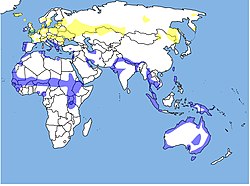| Godwit Temporal range: Barstovian–recent [1] | |
|---|---|
 | |
| Black-tailed (front) and bar-tailed godwit (back) | |
| Scientific classification | |
| Kingdom: | Animalia |
| Phylum: | Chordata |
| Class: | Aves |
| Order: | Charadriiformes |
| Family: | Scolopacidae |
| Genus: | Limosa Brisson, 1760 |
| Type species | |
| Scolopax limosa Linnaeus, 1758 | |
| Species | |
4, see text | |
Godwits are a group of four large, long-billed, long-legged and strongly migratory waders of the bird genus Limosa. Their long bills allow them to probe deeply in the sand for aquatic worms and molluscs. In their winter range, they flock together where food is plentiful. They frequent tidal shorelines, breeding in northern climates in summer and migrating south in winter. A female bar-tailed godwit made a flight of 29,000 km (18,000 mi), flying 11,680 kilometres (7,260 mi) of it without stopping. [2] In 2020 a male bar-tailed godwit flew about 12,200 kilometres (7,600 mi) non-stop in its migration from Alaska to New Zealand, previously a record for avian non-stop flight. [3] In October 2022, a 5 month old, male bar-tailed godwit was tracked from Alaska to Tasmania, a trip that took 11 days, and recorded a non-stop flight of 8,400 miles (13,500 km). [4]
Contents
The godwits can be distinguished from the curlews by their straight or slightly upturned bills, and from the dowitchers by their longer legs. The winter plumages are fairly drab, but three species have reddish underparts when breeding. The females are appreciably larger than the males.
Godwits were once popular as food in the British Isles. Sir Thomas Browne writing in about 1682 noted that godwits "were accounted the daintiest dish in England". [5]














